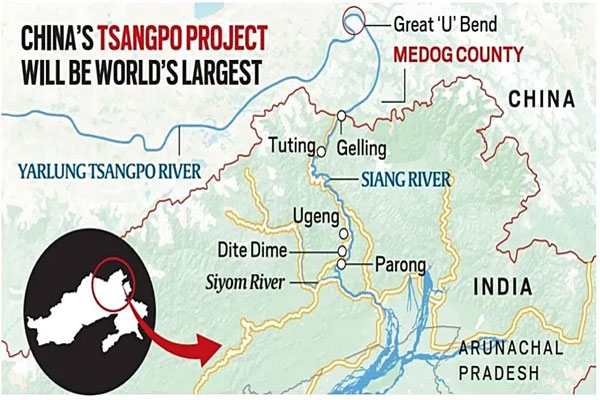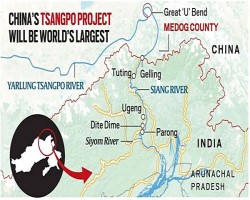On December 25, China approved the construction of the world’s largest hydropower project on the Yarlung Tsangpo (or Zangbo) river in Tibet. Once completed, this 60,000 MW project will generate three times the electricity produced by the current largest hydro project, the Three Gorges Dam on the Yangtze River in central China.
The Yarlung Tsangpo flows from Tibet into Arunachal Pradesh, where it is known as the Siang. Further downstream in Assam, it merges with tributaries like the Dibang and Lohit, becoming the Brahmaputra. It then flows into Bangladesh before emptying into the Bay of Bengal.
A project of this magnitude on the Yarlung Tsangpo has the potential to impact millions of people, their livelihoods, and the ecological balance in the regions it traverses.
“This is not just another project. It involves creating a massive reservoir in a challenging and sensitive region. It is risky, dangerous, and, in my view, highly irresponsible,” commented Ashok Kantha, a former Indian Ambassador to China.
On January 3rd, Ministry of External Affairs (MEA) spokesperson Randhir Jaiswal remarked: “As a lower riparian state with well-established rights to the river’s waters, we have consistently shared our concerns with the Chinese side regarding such mega projects. We have emphasized the need for transparency and consultation with downstream countries to ensure the interests of the Brahmaputra’s lower riparian states are safeguarded.”
What is the Yarlung Tsangpo Project?
Dr. Y. Nithiyanandam, Head of the Geospatial Research Programme at the Takshashila Institution in Bengaluru, explained that the proposed dam’s location is identified in China’s 14th Five-Year Plan (2021-2025). It is planned near the “Great Bend”, where the river makes a dramatic U-turn in Medog county before entering Arunachal Pradesh.
Recent developments, such as fund allocations, the construction of smaller dams along the river, and upstream land-use changes, indicate the project is moving into advanced planning stages, with visible construction likely to follow soon, Dr. Nithiyanandam highlighted.

Why Does China Pursue This Mega Project?
China claims the dam will aid in transitioning to renewable energy sources and help achieve net carbon neutrality by 2060. The Yarlung Tsangpo’s steep gradient and high flow rate make it ideal for hydroelectric power generation, according to Dr. Nithiyanandam.
China has previously constructed massive dams, such as the Three Gorges Dam, which have had significant environmental and social impacts. For instance, the dam’s reservoir weight is believed to have caused changes in gravity anomaly maps. The dam’s operations have displaced over a million people and caused severe ecological disruptions, he mentioned in a July 2023 article for Takshashila.
What Are the Concerns for India?
The dam could alter water flow from China to India, the lower riparian state. The bulk of the Brahmaputra’s water originates in Tibet, noted Kantha.
Additionally, large dams often lead to unintended consequences. The flow of silt, crucial for agriculture, may be disrupted, and changes in river flow could harm local biodiversity.
This region is both ecologically fragile and earthquake-prone. Kantha recalled a 2004 landslide in the Tibetan Himalayas that created the glacial Parechu Lake. When the lake burst in 2005, coordinated efforts between China and India mitigated the resulting flood’s impact.
“Even if unintentional, such incidents can have serious consequences. Building a large dam in an earthquake-prone area like this raises significant risks,” Kantha observed.
Mechanisms for Coordination Between India and China
India and China have an umbrella Memorandum of Understanding (MoU) on transboundary rivers, along with separate MoUs on the Brahmaputra and Sutlej.
The Sutlej MoU, established after the Parechu incident, has not been renewed due to China’s refusal to share year-round data. The Brahmaputra MoU, renewed every five years, expired in 2023, and renewal discussions are ongoing.
The umbrella MoU, signed in 2013, remains inactive. An Expert Level Mechanism, established in 2006 for annual meetings, has faced interruptions.
While both countries adhere to key principles of the 1997 United Nations Convention on the Law of the Non-Navigational Uses of International Watercourses, neither is a signatory.
What Options Does India Have?
“The broader issue is the lack of a comprehensive understanding or agreement,” Kantha noted. “China is reluctant to commit to binding agreements or acknowledge downstream concerns.”
China often asserts that its projects are run-of-the-river dams that do not involve significant water storage. Kantha argued that India must challenge such claims, especially when they dismiss the potential impacts on downstream regions.
“It’s crucial for India to raise this issue more forcefully, ensuring it becomes a significant point in bilateral engagements. If China continues to ignore our concerns, it will strain relations further,” he emphasized.
Kantha concluded that water issues should take center stage in India’s dialogue with China, as the stakes are high for millions dependent on these rivers.

